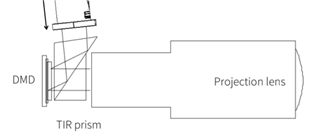Hello
I am designing a laser processing machine using DLP7000UV.
We are currently in the process of creating and experimenting with a prototype.
The optical system of the DMD mirror uses a prism as shown below.

I have the following questions regarding this.
Q1)
Why use this prism?
Is it to efficiently input and output light to the DMD?
Q2)
Will using this prism be a way to suppress DMD diffracted light?
Q3)
Is ±12deg a necessary condition for the light diffusion angle incident on the DMD?
Or should it be less than that?
If the light source is a laser, is it okay to use less than ±1°deg?
I would appreciate it if you could give me some advice.

